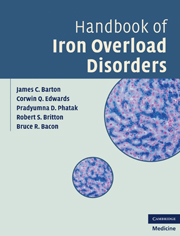Book contents
- Frontmatter
- Contents
- Foreword by Anthony S. Tavill
- Preface
- 1 History of iron overload disorders
- 2 Normal iron absorption and metabolism
- 3 Iron toxicity
- 4 Tests for hemochromatosis and iron overload
- 5 Complications of hemochromatosis and iron overload
- 6 Insulin resistance and iron overload
- 7 Infections and immunity
- 8 Classical and atypical HFE hemochromatosis
- 9 Heterozygosity for HFE C282Y
- 10 Porphyria cutanea tarda
- 11 Mitochondrial mutations as modifiers of hemochromatosis
- 12 Hemochromatosis associated with ferroportin gene (SLC40A1) mutations
- 13 Hemochromatosis associated with hemojuvelin gene (HJV) mutations
- 14 Hemochromatosis associated with hepcidin gene (HAMP) mutations
- 15 Hemochromatosis associated with transferrin receptor-2 gene (TFR2) mutations
- 16 Iron overload associated with IRE mutation of ferritin heavy-chain gene (FTH1)
- 17 Hereditary hyperferritinemia-cataract syndrome: IRE mutations of ferritin light-chain gene (FTL)
- 18 Iron overload in Native Africans and African-Americans
- 19 Hereditary atransferrinemia
- 20 Divalent metal transporter-1 (SLC11A2) iron overload
- 21 Iron overload associated with thalassemia syndromes
- 22 Iron overload associated with hemoglobinopathies
- 23 Iron overload associated with pyruvate kinase deficiency
- 24 Iron overload associated with congenital dyserythropoietic anemias
- 25 Hereditary sideroblastic anemias
- 26 Pearson marrow–pancreas syndrome
- 27 Acquired sideroblastic anemias
- 28 Hereditary aceruloplasminemia
- 29 Friedreich ataxia and cardiomyopathy
- 30 Pantothenate kinase (PANK2)-associated neurodegeneration
- 31 Neuroferritinopathies
- 32 GRACILE syndrome
- 33 Neonatal hemochromatosis
- 34 Iron overload due to excessive supplementation
- 35 Localized iron overload
- 36 Management of iron overload
- 37 Population screening for hemochromatosis
- 38 Ethical, legal, and social implications
- 39 Directions for future research
- Index
- Plate section
- References
27 - Acquired sideroblastic anemias
Published online by Cambridge University Press: 01 June 2011
- Frontmatter
- Contents
- Foreword by Anthony S. Tavill
- Preface
- 1 History of iron overload disorders
- 2 Normal iron absorption and metabolism
- 3 Iron toxicity
- 4 Tests for hemochromatosis and iron overload
- 5 Complications of hemochromatosis and iron overload
- 6 Insulin resistance and iron overload
- 7 Infections and immunity
- 8 Classical and atypical HFE hemochromatosis
- 9 Heterozygosity for HFE C282Y
- 10 Porphyria cutanea tarda
- 11 Mitochondrial mutations as modifiers of hemochromatosis
- 12 Hemochromatosis associated with ferroportin gene (SLC40A1) mutations
- 13 Hemochromatosis associated with hemojuvelin gene (HJV) mutations
- 14 Hemochromatosis associated with hepcidin gene (HAMP) mutations
- 15 Hemochromatosis associated with transferrin receptor-2 gene (TFR2) mutations
- 16 Iron overload associated with IRE mutation of ferritin heavy-chain gene (FTH1)
- 17 Hereditary hyperferritinemia-cataract syndrome: IRE mutations of ferritin light-chain gene (FTL)
- 18 Iron overload in Native Africans and African-Americans
- 19 Hereditary atransferrinemia
- 20 Divalent metal transporter-1 (SLC11A2) iron overload
- 21 Iron overload associated with thalassemia syndromes
- 22 Iron overload associated with hemoglobinopathies
- 23 Iron overload associated with pyruvate kinase deficiency
- 24 Iron overload associated with congenital dyserythropoietic anemias
- 25 Hereditary sideroblastic anemias
- 26 Pearson marrow–pancreas syndrome
- 27 Acquired sideroblastic anemias
- 28 Hereditary aceruloplasminemia
- 29 Friedreich ataxia and cardiomyopathy
- 30 Pantothenate kinase (PANK2)-associated neurodegeneration
- 31 Neuroferritinopathies
- 32 GRACILE syndrome
- 33 Neonatal hemochromatosis
- 34 Iron overload due to excessive supplementation
- 35 Localized iron overload
- 36 Management of iron overload
- 37 Population screening for hemochromatosis
- 38 Ethical, legal, and social implications
- 39 Directions for future research
- Index
- Plate section
- References
Summary
Acquired sideroblastic anemia is a heterogeneous group of disorders characterized by excessive accumulation of amorphous iron deposits in the mitochondria of erythrocyte precursors. Ring sideroblasts, the sine qua non of sideroblastic anemia, are erythroblasts in Prussian blue-stained marrow aspirates that have numerous iron-positive mitochondria that occur in a perinuclear distribution. In sideroblastic anemia, typical ring sideroblasts have a full or partial ring and usually comprise more than 5% of all erythroblasts (Chapter 25, Fig. 25.1a, b). Other erythroblasts in the same specimens may have markedly increased numbers of iron-positive mitochondria that do not form a perinuclear halo. Acquired sideroblastic anemias encompass two main categories: clonal hematopoietic stem cell disorders classified as myelodysplastic syndromes (MDS); and reversible types of sideroblastic anemia due to drugs, chemicals, or other factors. Heritable types of sideroblastic anemia are described in Chapter 25.
Acquired sideroblastic anemia due to myelodysplastic syndromes
Classification
Refractory anemia with ring sideroblasts (RARS) is characterized by erythroid dysplasia, mitochondrial accumulation of mitochondrial iron-containing ferritin (mitoferrin), defective erythroid maturation, and anemia; some patients also have elevated platelet counts. Other patients with MDS and ring sideroblasts are classified as having refractory cytopenias with multilineage dysplasia and ring sideroblasts (RCMD-RS). MDS in patients with either RARS or RCMD-RS may progress to excess marrow blasts (refractory anemia with excess blasts, RAEB) or acute leukemia.
Pathophysiology
Non-germline mutations in marrow stem cells underlie the pathogenesis of MDS, including MDS subcategories typically associated with ring sideroblasts.
- Type
- Chapter
- Information
- Handbook of Iron Overload Disorders , pp. 277 - 283Publisher: Cambridge University PressPrint publication year: 2010



